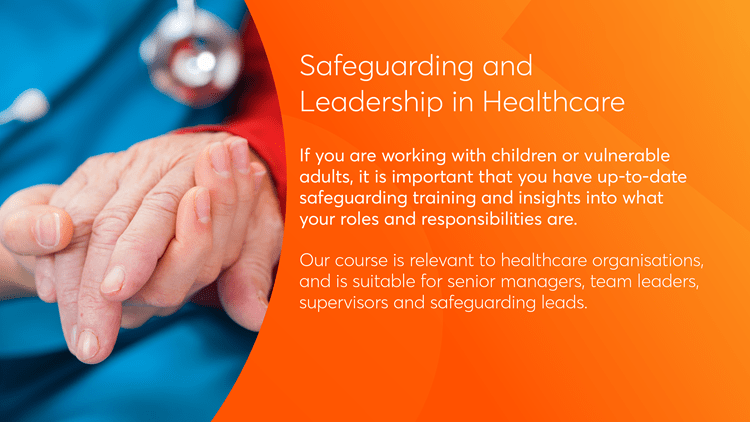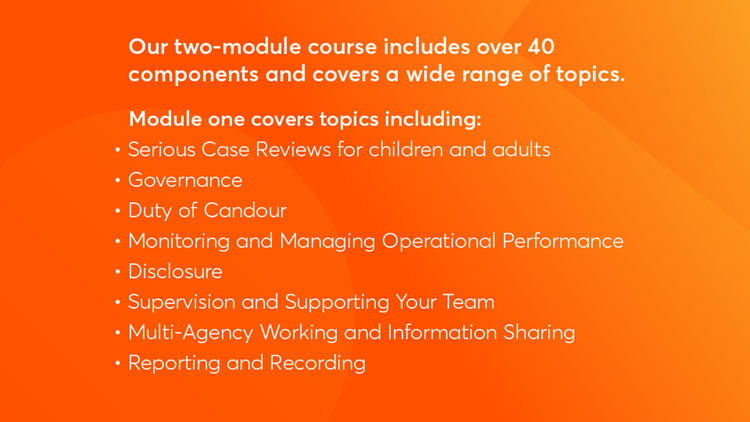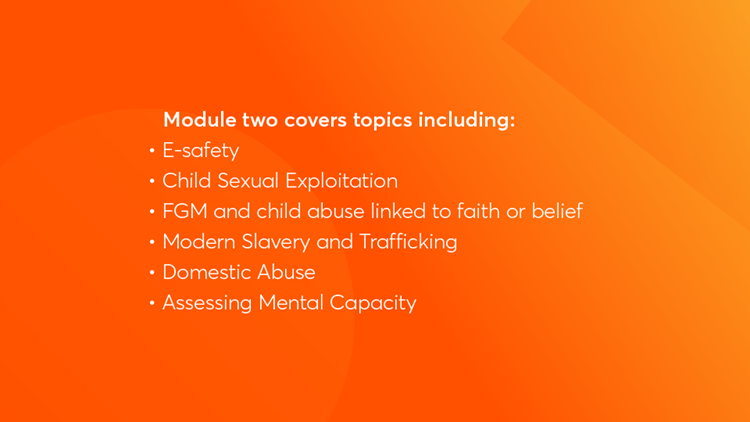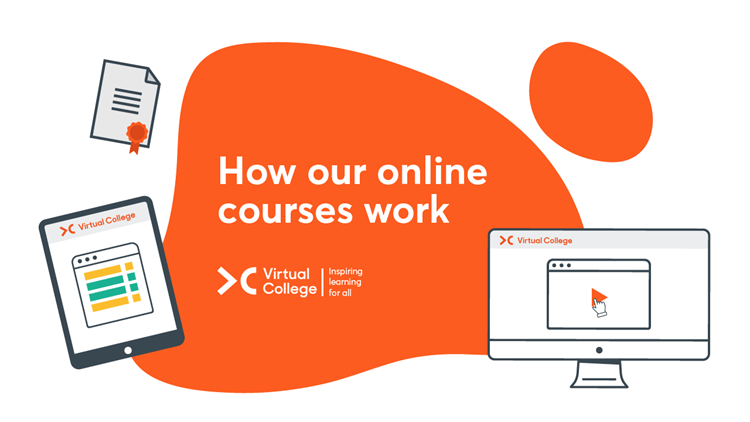Safeguarding and Leadership in Healthcare









Course Overview
Format
- Advanced
- 12+ Study Hours
- Online Study
- Self-Printed Certificate
Accreditation
- Online Interactive Course
- Virtual College Endorsed
Course description
Our in-depth course provides extensive guidance and learning regarding the roles and responsibilities of the safeguarding leads and managers in healthcare.
Anyone who works with children or vulnerable adults understands that safeguarding is an important part of their role.
The leadership roles and responsibilities cover many different topics and safeguarding areas, so up-to-date and in-depth knowledge is vital.
Our course is split into two modules – Core, and Further Learning - each with over 20 components.
The Core module covers topics such as serious case reviews, duty of candour, how to support your team and how the disclosure responsibilities. Whereas the Further Learning module explores specific safeguarding topics ranging from e-safety to child sexual exploitation and abuse relating to faith and belief.
We put the learner at the heart of our learning, and this course has been designed in bite-sized chunks to allow you to dip in and out at your own time and pace, and undertake the learning in the order that works for you.
It is also filled with challenges, downloadable resources, videos and scenarios activities to ensure that the learning is meaningful and relevant but also interactive and engaging, ensuring a positive learning experience.
Learning Objectives
Module one: Core
- Governance, why it is important, and how to apply it
- Duty of Candour, relevant policies and procedures
- The importance of ‘safeguarding disclosures’, the responsibilities and roles of groups and named or designated professionals, and the overall response to a safeguarding disclosure
- How supervision is linked to performance and improvement, and the responsibilities of a supervisor
- The skills needed to support and manage stress, wellbeing, and resilience
- The impact of Serious Case Reviews on Adult and Child Practice Reviews, and their contribution to safeguarding legislation and policy
- The legislation, guidance and regulation relating to health and social care
- The signs and signals of abuse in both children and adults, how and why to report effectively record it
- The benefits of multi-agency working and information sharing, and the framework in place to facilitate it
- The roles and responsibilities relevant to job roles and organisations, for both children and adults, across sectors
Module two: Further learning
- The ways children and young people use technology and the internet, identify e-safety practices, how to report online abuse and how to seek further support
- Cyberbullying, the triggers for cyberhate, and the risks and consequences for victims.
- Online abuse relating to children and the process of grooming
- How to assess risk in Child Sexual Exploitation
- FGM, abuse linked to faith or belief, and honour-based violence, and how to help children and adults in vulnerable situations
- The motives and indicators of forced marriage, and potential consequences for victims
- Who is at risk of modern slavery, the indicators, and the National Referral Mechanism
- The definition of trafficking and its causes and consequences
- Indicators of radicalisation and the government’s Prevent and CONTEST strategies against radicalisation and extremism
- Signs of domestic violence and how to help adults and children at risk
- Why assessing mental capacity is important
- Legislation relating to these issues
Who should take this course
Our Safeguarding and Leadership in Healthcare course is suitable for a wide range of roles and is aimed at those working in the healthcare sector. The roles include senior managers, team leaders, safeguarding leads and anyone working with children and/or adults in the workplace.
Duration
Our online course will take over 12 hours to complete. The length of time taken depends entirely on how quickly you can study and absorb the material. You can proceed as quickly or slowly as you like, and there is no limit on how long you can take to do the course and your progress will be automatically saved so you can log in and out as you please.
Entry requirements
There are no specific entry requirements for this course.
Test and certificate
Each end of course test consists of 15 multiple choice questions. Learners are required to achieve a 75% pass mark, and, if necessary, may attempt the test six times at no extra cost.
If learners do not achieve the 75% pass mark, further attempts may be given by contacting our support team.
Learners will be able to download a digital certificate on completion. This can be printed, and we suggest you keep it for your records.
You will learn
- Governance, why it is important, and how to apply it
- Duty of Candour, relevant policies and procedures
- The importance of ‘safeguarding disclosures’, the responsibilities and roles of groups and named or designated professionals, and the overall response to a safeguarding disclosure
- How supervision is linked to performance and improvement, and the responsibilities of a supervisor
- The skills needed to support and manage stress, wellbeing, and resilience
- The impact of Serious Case Reviews on Adult and Child Practice Reviews, and their contribution to safeguarding legislation and policy
- The legislation, guidance and regulation relating to health and social care
- The signs and signals of abuse in both children and adults, how and why to report effectively record it
- The benefits of multi-agency working and information sharing, and the framework in place to facilitate it
- The roles and responsibilities relevant to job roles and organisations, for both children and adults, across sectors
- The ways children and young people use technology and the internet, identify e-safety practices, how to report online abuse and how to seek further support
- Cyberbullying, the triggers for cyberhate, and the risks and consequences for victims.
- Online abuse relating to children and the process of grooming
- How to assess risk in Child Sexual Exploitation
- FGM, abuse linked to faith or belief, and honour-based violence, and how to help children and adults in vulnerable situations
- The motives and indicators of forced marriage, and potential consequences for victims
- Who is at risk of modern slavery, the indicators, and the National Referral Mechanism
- The definition of trafficking and its causes and consequences
- Indicators of radicalisation and the government’s Prevent and CONTEST strategies against radicalisation and extremism
- Signs of domestic violence and how to help adults and children at risk
- Why assessing mental capacity is important
- Legislation relating to these issues
Who is it for?
Roles including:
- Senior Managers
- Team Leaders
- Safeguarding Leads
- Anyone working with children and/or adults in the workplace
Legislation
Legislation covered in this course includes:
Module one: Core
- Health and Social Care Act 2012
- Health and Social Care Act 2008 (Regulated Activities) (Amendment) Regulations 2015
- Data Protection Act 2018 and GDPR 2015
- The Care Act 2014
- Children Act 2004
Module Two: Further learning
- Public Order Act 1986
- Malicious Communications Act 1988
- Protection from Harassment Act 1997
- Communications Act 2003
- Digital Economy Act 2017
- Protection of Children Act 1978
- Criminal Justice and Courts 2015
- Human Rights Act 1998
- The Modern Slavery Act (England and Wales) 2015
How the online courses work
-
Find a course
To begin searching for your online training you can click on the course category section on our website and browse through all of our training categories.
Alternatively if you already know the title of the training you’re looking for you can use the search bar located in the centre of the homepage and go directly to the course you want.
-
Buy the course
When buying one of our courses, you will need to enter a valid email address which will be used to create your account with our Learning Management System – Enable – where you will take the training. We will also send your purchase receipt to this email address, and any additional courses purchased in future using the same email address will be added to your system account.
Once you have purchased a course, you will be able to send this course to other people using your system account with Enable by entering the new learner’s email address so that they may access the training and set up their own system account with our Learning Management System.
If you are not 100% satisfied with your course then we offer a 30-day, no hassle money-back guarantee. To request a refund, you should email our learner support team with your receipt stating why you would like to be reimbursed. You, or your learners, must not have completed the training in order to make a valid refund claim. Any claim made after the training has been completed will be invalidated.
-
Take the course
This online course consists of a series of pages in which an instructor will talk learners through the lesson material. Pages may include supporting pictures, graphs, animation or extra sounds to help with the learning where appropriate. Some lessons will include challenges/quizzes to help learners stay engaged and interested in the material. Lessons can be taken in any order and each lesson may be paused and resumed at any stage.
The course is self-paced so learners decide how fast or slow the training goes. There is no deadline for completion but some of our courses have a test at the end to check that learners have understood the material. If the course has a test at the end then learners are required to achieve a 75% pass mark to successfully complete the course. Once learners have passed the test they are awarded a certificate, which can either be downloaded digitally or sent as a physical copy if this option was chosen when purchasing the course.
-
Your Certificate
Upon completion of any of our courses, learners will be able to download a digital certificate from Virtual College and will include the accrediting bodies logo where applicable.
If you have bought the posted certificate option (available on select courses), a high quality, seal embossed, certificate will be sent out at the beginning of the following working week.



















